
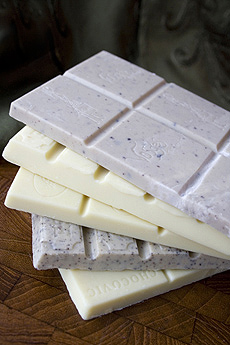 White chocolate. The darker bars have inclusions: olives in the tip bar and ground coffee beans in the fourth bar. Photo by Claire Freiermann | THE NIBBLE from our review of The World’s Best White Chocolate, a NIBBLE Top Pick Of The Week.
March 2005
Last updated February 2025
|
 |
Chocolate Glossary
Chocolate Terms & Definitions: U To Z
Here you’ll find terms including vanilla, varietal and white chocolate. If you think we should consider chocolate terms and definitions other than those we have provided, click on the Contact Us link on this page. Also enjoy our 100+ other food glossaries. Like food history? Check out our 750+ histories of your favorite foods.
Use this index bar to visit other pages.
a b c d e f g h i j k l m n o p q r s t u v w x y z
This glossary is protected by copyright and cannot be reproduced in whole or part.
UNROASTED CHOCOLATE
While most chocolate is made with roasted cacao beans, some artisan producers make bars with unroasted beans. The difference: Dark chocolate with roasted beans tends to have a more intense and deeper flavor. The heat from the roasting process brings out complex, nutty, and smoky notes. It also helps to develop the chocolate’s characteristic bitterness and reduces the raw, acidic flavors.
Unroasted beans yield a more delicate and fruity taste. Since the beans retain more of their raw, natural flavors including origin-specific notes, the chocolate that results is lighter, fresher, and sometimes more acidic or floral. The flavor of the chocolate will be brighter and even tangy compared to the roasted version.
UNSWEETENED CHOCOLATE
Solid chocolate made from 100% chocolate liquor, with no sugar or emulsifiers added. Top-quality 100% cacao bars are excellent for eating if one likes intense cacao flavor. Note: some people in the trade refer to chocolate liquor as unsweetened chocolate.
VANILLA
Vanilla is the flavor extract derived from the vanilla bean, the pod of a tropical orchid. The pods are harvested green and cured, turning brown when heated in ovens. Each pod contains numerous seeds. Vanilla extract is made by chopping or macerating beans, then mixing them with ethyl alcohol and water, aging the solution, and filtering out the solids. Pure vanilla extract must be 35% alcohol by volume. Vanilla is native to southern Mexico, although the majority of today’s supply comes from Madagascar (known as bourbon vanilla); secondarily from Tahiti (the finest and rarest); Mexico is the third largest source. Almost all fine chocolate is enhanced with vanilla. Just as with cacao beans, vanilla from different parts of the world has different flavor complexities, and specific vanillas are paired with specific chocolates to achieve different results. The Madagascar bean (Bourbon bean) is very thin and very rich in sweetness. It has a thick oily skin that covers many small seeds that provide a strong vanilla aroma. The Mexican bean is not as thin and not quite as sweet as the Madagascar bean. The bean has a somewhat earthy aroma and is more mellow in flavor than the bourbon bean. The Tahiti bean is plumper in size, darker in color, and the least sweet of the beans. Its thin-skinned pod covers fewer seeds than the other varieties and they have a slightly fruity aroma. While the orchid family is the second largest family of flowering plants with approximately 20,000 species, the Vanilla genus is the only group that produces anything edible. See our comprehensive article on vanilla.
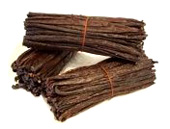 |
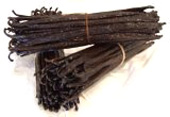 |
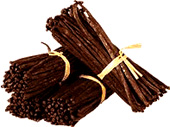 |
| Bourbon or Madagascar Vanilla (Vanilla planifolia). The vanilla we are most familiar with (it flavors our desserts and is used to make vanilla extract) originated in Mexico. In the 1800s cuttings were taken by the French in large plantations on the island of Reunion, then known as the Ile de Bourbon. Click here to purchase 6 beans. |
Mexican Vanilla (Vanilla mexicana). Mexican vanilla beans are some of the most expensive in the world. They are long glossy pods with strong vanilla aromas and provide rich chocolate tones. The Aztecs used it to flavor their cold, unsweetened chocolate drink. Click here to purchase 6 beans. |
Tahitian Vanilla (Vanilla tahitensis). Earthy and fruity with a floral fragrance, the Tahitian bean is fatter and moister than the Bourbon (Madagascar) bean, and it contains less natural vanillin, giving it a more complex, but less strong vanilla flavor. Click here to purchase 6 beans. |
VANILLA EXTRACT
Vanilla beans are expensive and time-consuming to split open and work with to flavor dishes. To save time and money, an extract is produced by steeping vanilla beans in an alcohol and water solution; the alcohol and water cook out, leaving the essence. Pure vanilla is concentrated and only a small amount is needed for flavoring. However, it is an expensive flavoring to produce, which has led to the proliferation of synthetically produced vanilla—vanillin. This is generally labeled Artificial Vanilla Extract at retail, but the word artificial is often in small letters: look closely to avoid purchasing the wrong product. See our recommendations of the best vanilla extract brands.
VANILLIN
Natural vanillin is a white crystalline compound found in the pulp of vanilla beans and is the largest component in vanilla. The flavoring ethyl vanillin is manufactured commercially, an artificial by-product of the wood pulp used in the paper industry. Ethyl vanillin is substituted for vanilla in lesser chocolate. It can often be identified by a strong vanilla smell: Natural vanilla is much more subtle.
VARIETAL
A biological variety; a chocolate made from one particular subspecies of beans: Criollo, Forastero, or Trinitario. Borrowed from wine terminology, where it refers to a wine made principally from one variety of grape and carrying the name of that grape, e.g. Cabernet Sauvignon, Chardonnay, Pinot Noir. The term is also used to describe coffee beans and other fruits like peppercorns; another term, cultivar, is used for fruits like avocados and olives.
-
WHITE CHOCOLATE
White chocolate was introduced in the 1930s by the Nestlé Company. It is a blend of cocoa butter, sugar or other sweetener, vanilla, and soy lecithin as an emulsifier. White chocolate contains no cocoa solids (chocolate liquor). For many years, white chocolate was not classified as chocolate but as confectionary. The old U.S. Standards of Identity stated that in order to be called chocolate, a product must contain chocolate liquor. The Standards of Identity were amended in 2002 to allow white chocolate to be called chocolate if, among other requirements, it is made from a minimum of 20% cocoa butter. When it was not officially “chocolate,” many manufacturers, especially of mass-market white chocolate, used vegetable oil instead of cocoa butter, and the taste difference is significant. Some people who say they do not like “white chocolate” may never have tasted the real thing. Real white chocolate is rich and creamy and tastes like chocolate. In addition to the minimum 20% cocoa butter, to be called white chocolate, the product must have a minimum of 15% milk powder and a maximum of 55% sweetener.
|
|
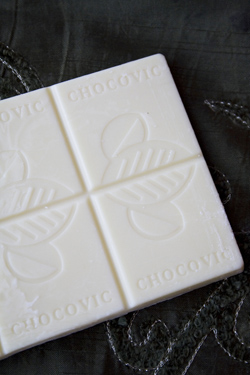
White chocolate, though a member of the family, is not technically chocolate because it contains no cocoa solids. If it did, it wouldn't be white! Originally developed as a lighter summer confection, white chocolate is sometimes referred to as white milk chocolate because, like milk chocolate, it is made of cocoa butter, milk, and flavorings (though milk chocolate does contain cocoa solids). Photo of Chocovic white chocolate by Claire Freiermann | THE NIBBLE. |
-
Any other formulation must still be called confectionary or summer coating. When a white chocolate bar has a percentage on the label similar to a cacao bar, e.g. 33%, it is not referring to the percentage of cacao in the bar (as there are no cocoa solids in white chocolate) but to the percentage of cocoa butter. The higher the percentage of cocoa butter, the richer and creamier the bar. Many experts feel that El Rey’s white chocolate, Icoa, is the finest in the world. Other manufacturers deodorize all of their cocoa butter (which is pressed from the cocoa bean), to remove all of the flavors. They do this because their purpose is to add this cocoa butter back into the chocolate liquor (also called cocoa solids and other names) to increase is fluidity (creaminess) without affecting the flavor. To this end, a deodorized, flavorless, cocoa butter is perfect for milk chocolate and dark chocolate production. But, it makes white chocolate, which has no chocolate liquor, taste blander. That’s why Icoa is considered the paragon of white chocolate among connoisseurs. See our review of the best white chocolate.
WHOLEFRUIT CHOCOLATE
WholeFruit chocolate is a fruity chocolate made from 100% pure cacao fruit. It uses parts of the fruit that are typically discarded as waste. Normally 70% of the cacao fruit is discarded as waste, using only the seeds (beans) to make chocolate. With WholeFruit, the fresh, fruity pulp of the pod is also used in this new type of chocolate, creating a unique sensory and nutritional profile. WholeFruit chocolate was created by Barry Callebaut, the world’s leading manufacturer of high-quality chocolate and cocoa (and also the inventor of ruby chocolate (pink in color), the fourth type of chocolate after dark, milk, and white. In 2021 WholeFruit was made available to artisans and chefs. In 2023, it will be available for consumer brands. The chocolate comes in two variants equating to dark and milk: WholeFruit Bold (100% Pure cacaofruit) and WholeFruit Velvety (100% Pure cacaofruit+Milk).
XOCOATL or XOCOLATL
Pronounced shock-WA-tel, the Mayan word for chocolate. It means bitter water. The original chocolate beverage was an unsweetened drink mixed with maize and flavored with pepper and other savory spices. The word “cacao” originated with the Olmec peoples who occupied the lowland regions of the eastern Mexican gulf coast; originally pronounced kakawa, “cacao” derived from the Mixe-Zoquean family of languages spoken by the Olmec, and was probably in use by 1000 B.C.* The Olmec shared their knowledge of cacao with the adjacent Mayans. The Nahuatl (Aztec language) term cacahuatl for cacao was concocted from the Mayan word. See chocolate for the etymology of the word.
*The True History of Chocolate, Sophie Coe and Michael Coe.
Lifestyle Direct, Inc. All rights reserved. Images are the copyright of their respective owners.

|




 White chocolate. The darker bars have inclusions: olives in the tip bar and ground coffee beans in the fourth bar. Photo by Claire Freiermann | THE NIBBLE from our review of
White chocolate. The darker bars have inclusions: olives in the tip bar and ground coffee beans in the fourth bar. Photo by Claire Freiermann | THE NIBBLE from our review of 


